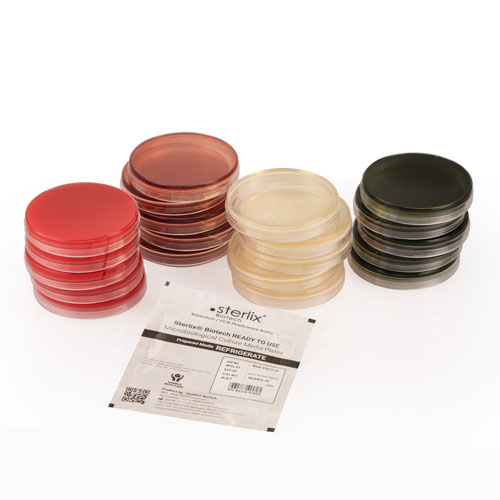STERLIX® Macconkey Ready To Use Agar Plate
Product Details
MacConkey agar plate, named after its developer Alfred Theodore MacConkey, is a selective and differential culture medium used in microbiology laboratories. It is primarily employed for the isolation and differentiation of gram-negative bacteria, particularly members of the family Enterobacteriaceae.
The key components of MacConkey agar include:
Bile salts and crystal violet: These selective agents inhibit the growth of gram-positive bacteria, allowing for the selective isolation of gram-negative bacteria.
Lactose: MacConkey agar contains lactose as the carbohydrate source. It helps differentiate bacteria based on their ability to ferment lactose.
Neutral red: This pH indicator turns colonies that ferment lactose into pink or red color, aiding in the differentiation of lactose fermenters from non-fermenters.
MacConkey agar can distinguish bacterial colonies based on the following characteristics:
Lactose fermenters: Bacteria capable of fermenting lactose produce acid as a byproduct, causing the agar surrounding their colonies to turn pink or red.
Non-lactose fermenters: Bacteria that do not ferment lactose do not produce acid and, therefore, do not cause a color change. These colonies typically remain colorless or pale.
Neutral colonies: Some organisms, such as Salmonella and Shigella species, do not ferment lactose but can grow on MacConkey agar. These colonies appear as transparent or colorless due to their inability to metabolize lactose.
MacConkey agar is particularly useful for the identification and differentiation of enteric pathogens, including Escherichia coli, Klebsiella pneumoniae, Enterobacter aerogenes, and Proteus mirabilis, among others. It plays a vital role in clinical diagnostics, allowing for the detection of pathogens associated with urinary tract infections, gastrointestinal disorders, and other related conditions.
It's important to note that MacConkey agar is a selective medium and is not suitable for the growth of fastidious or non-enteric bacteria. For the isolation of other types of microorganisms, different selective and differential media are used.
The key components of MacConkey agar include:
Bile salts and crystal violet: These selective agents inhibit the growth of gram-positive bacteria, allowing for the selective isolation of gram-negative bacteria.
Lactose: MacConkey agar contains lactose as the carbohydrate source. It helps differentiate bacteria based on their ability to ferment lactose.
Neutral red: This pH indicator turns colonies that ferment lactose into pink or red color, aiding in the differentiation of lactose fermenters from non-fermenters.
MacConkey agar can distinguish bacterial colonies based on the following characteristics:
Lactose fermenters: Bacteria capable of fermenting lactose produce acid as a byproduct, causing the agar surrounding their colonies to turn pink or red.
Non-lactose fermenters: Bacteria that do not ferment lactose do not produce acid and, therefore, do not cause a color change. These colonies typically remain colorless or pale.
Neutral colonies: Some organisms, such as Salmonella and Shigella species, do not ferment lactose but can grow on MacConkey agar. These colonies appear as transparent or colorless due to their inability to metabolize lactose.
MacConkey agar is particularly useful for the identification and differentiation of enteric pathogens, including Escherichia coli, Klebsiella pneumoniae, Enterobacter aerogenes, and Proteus mirabilis, among others. It plays a vital role in clinical diagnostics, allowing for the detection of pathogens associated with urinary tract infections, gastrointestinal disorders, and other related conditions.
It's important to note that MacConkey agar is a selective medium and is not suitable for the growth of fastidious or non-enteric bacteria. For the isolation of other types of microorganisms, different selective and differential media are used.

